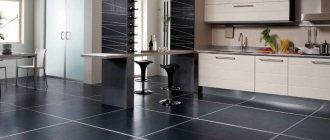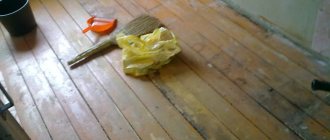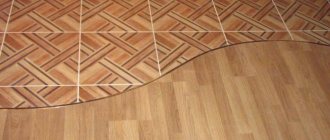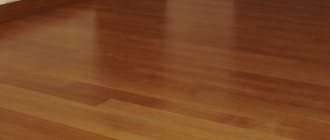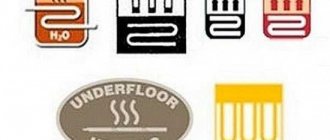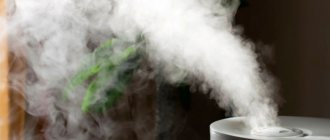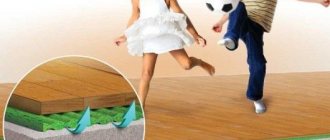It is widely believed that of all the lining materials, it is the cheapest and easiest to lay linoleum on fiberboard. In terms of price, it’s hard to argue; on average, a sheet of fiberboard costs two to three times less than the most popular OSB panel of the same size in home construction. Laying linoleum on fiberboard with your own hands may turn out to be a less labor-intensive task, but certainly the process will not be easier.
Laying without lining material
Is it possible to lay linoleum on fiberboard?
The opinions of modern craftsmen on this issue differ; fiberboard or its more modern version - hardboard - has been used as a substrate for decades. They began laying linoleum on it on the second day after it went on sale. But there are still experts who believe that laying linoleum on hardboard is ineffective and short-lived, although practice clearly confirms the opposite. Another thing is that linoleum flooring on fiberboard requires scrupulous adherence to technology. If you do not take the waterproofing of pressed fiber more or less seriously, then it is better to immediately lay linoleum on bakelite-impregnated plywood and breathe in phenol and formaldehyde for the rest of your life.
There are several critical points in laying hardboard on the floor under linoleum:
- A slab or sheet of compressed wood fiber has good thermal insulation and high shock-absorbing properties. At the same time, a thin sheet, only 3-5 mm, adapts well to linoleum fabric. If linoleum on OSB and even plywood can break at the joints, then when laid on fiberboard both materials behave as one whole;
- Before laying fiberboard, it is necessary to solve the problem of waterproofing, especially if the material will come into contact with moist cold air or a surface with a temperature below 7°C.
For your information! Of all the options for substrates for laminate, fiberboard can be considered the safest. The content of protective impregnations, not counting paraffin and rosin, in the composition of wood-fiber boards is 40% less than that of its closest competitor - OSB.
True, you have to pay for this with almost zero water resistance and low rigidity. A relative of fibreboard, hardboard is made using a technology that provides smooth surfaces on both sides of the sheet. This is achieved by special pressing of a rosin-paraffin mixture and the finest fiber-wood powder. It is this material that is recommended to be laid under laminate or linoleum. A standard building fiber board has a smooth surface on one side. Therefore, if you use it for a substrate and, moreover, try to glue linoleum to fiberboard with glue, you will have to use at least two layers of slabs, each at least 3.5 mm thick.
Laying linoleum on bitumen mastic
This is probably the most common way. Mastic in itself is considered a good waterproofing agent. Its paste-like formula is able to penetrate into small cracks, further leveling the base. When using mastic, you need to choose a special primer designed specifically for it.
More information needs to be said about how to lay linoleum on mastic. After spreading the paste-like composition over the floor and laying linoleum on it, it is necessary to level it with a roller from the middle to the edges. This will help remove any air bubbles. Excess mastic that appears at the edges is removed with a rag.
If large swellings form, you need to press down these places with a sheet of plywood or a wide board with a weight. Leave it like this for several days.
How to prepare fiberboard for laying linoleum
Material purchased at a construction showroom, as a rule, does not require additional preparation. Due to the fact that fiberboard is stored horizontally in a bundle, the geometry of the sheet does not require special modification or adjustment.
The sheet size is selected individually
The only problem may be the size of the slab. The most common format of a fiberboard board is the size of 1.22x2.44 m. For a standard room of 15-18 m2, four sheets are needed. In other cases, the material must be pre-cut to make it convenient to bring it into the room and lay it on the floor.
Correcting the geometry
If the fiberboard was purchased ahead of time and stored in an unheated room, then most likely the geometry of the sheets was damaged. It is imperative that the situation be corrected before the fiberboard needs to be laid on the floor.
Fibreboard should be stored in stacks in a dry place
To level the sheet you will need two sheets of OSB, plastic film and a weight:
- The material is slightly moistened with clean water from a hand sprayer;
- Cover with plastic film from the bottom and top;
- Stacked between two OSB panels;
- Load with oppression.
In dry, hot weather, straightening will take a maximum of a few days. Fiberboard sheets removed from the stack should be immediately laid on the floor under the linoleum. Slightly increased humidity will only improve the adherence of the slab to the base. If the material is planned to be treated with protective coatings, it will have to be dried in a pile for at least two weeks until the remaining water is completely removed.
How to treat before laying the slab under linoleum
Most novice finishers prefer not to treat the fiberboard before laying it on the floor. It is believed that it is enough to lay the sheets on a rough base for some time, for 5-7 days, so that, as they say, they “rest”, as in the case of rolling out linoleum. This may help install the fiberboard, or it may cause problems as the material may pick up moisture. It all depends on the conditions in which you plan to lay linoleum.
When laying on concrete, the slab must be treated with paint or varnish.
Advice! It is best to saturate the fiberboard surface with wood varnish immediately after purchasing the material.
The paper base absorbs oil and pentaphthalic varnishes very well, so the consumption of paints and varnishes is simply enormous. Sometimes craftsmen, in order to save on impregnation, apply an emulsion of water and PVA to the fiberboard. As a result, a thin film is formed that prevents the varnish from absorbing too much.
Properties of linoleum
Commercial linoleum is a convenient and economical thing. It is laid quite easily, and if installed correctly it can last up to 25 years. There are two types of commercial linoleum - homogeneous and heterogeneous coating.
Homogeneous coating is a durable and elastic linoleum, uniform throughout its thickness. Its pattern penetrates through the entire homogeneous layer of linoleum. Even with severe wear and surface damage, its appearance does not change. That is why homogeneous coating is ideal in corridors and other places where the floor is heavily used.
Due to the characteristics of a homogeneous coating, its pattern does not differ in diversity. It can be a single-color canvas, abstract patterns “marbled”, “granite-like”. This pattern is perfect for offices. But the monotony of appearance is compensated by the advantages:
- wear resistance
- durability
- antistatic
- ease of maintenance.
- the appearance of the coating can be restored.
Homogeneous coating is in demand in places where there is possible severe mechanical damage to the floor, as well as in offices and rooms with computer and high-tech equipment, which are harmful to static electricity.
The top layer of homogeneous linoleum is PVC. Since polyvinyl chloride is a fairly expensive material, talc or lime can be added to the raw material to reduce the cost of production.
If, when you bend a sheet of homogeneous coating in half, a white stripe appears, it means there is too much limestone in its composition. Mixing with surface dirt, limestone forms whitish stains that cannot be destroyed with regular wet cleaning of the room. This coating must be sanded periodically.
Heterogeneous linoleum is based on fiberglass coated with a polyurethane coating. The method of manufacturing heterogeneous flooring allows us to achieve a huge variety of colors and patterns. Its varieties:
- sound absorption
- antistatic
- anti-slip - the production technology of heterogeneous linoleum makes it possible to make its surface textured and covered with pimples. Metal chips are added to the mixture.
- conductive
- depreciation.
Multilayer coating is in demand in rooms with high humidity, as well as where increased sound or heat insulation is required.
Having chosen which coating will be most suitable for the room, you should decide whether to lay the linoleum yourself or invite specialists. The question arises - how much does it cost to lay linoleum?
The price of laying commercial linoleum varies from 110 RUR/m2 to infinity. The cost of the material itself starts from 400 rubles per meter. You must pay separately for welding seams. At the same time, the cost of the work also includes preparation of the surface for the finishing coating.
Is it necessary to dry fiberboard under linoleum?
There is always a problem of how to protect the paper base of the board from moisture and water vapor. The simplest and most inexpensive way is to use oil varnishes and drying oils. For varnish protection, you can treat fiberboard under linoleum, long before it is time to lay the slab.
Drying oil protects no worse, but dries very poorly. Therefore, it is necessary to dry the material only if the sheets are planned to be glued to concrete. Otherwise, the process of laying linoleum will turn into torture, the drying oil will stain everything. In addition, not any glue allows you to lay linoleum on a coated surface. If you lay linoleum on drying oil, then in 10-15 years, when it is time to replace it, you can only remove the coating with the backing.
Laying a wood-fiber base under linoleum
Among other things, it is important to properly prepare the fiberboard floor. You can lay the material in three ways:
- Stick on the base;
- Place on dowels;
- Leave it free.
The specific method is selected based on the base material. If you plan to lay linoleum in a private house without a basement and with earthen floors, then fiberboard cannot be used. Even with insulation and double waterproofing, moisture will still reach the wood-fiber base, and the linoleum will rot. At a minimum, you will need to make a concrete screed and ventilation.
Before processing, the gap at the joint is at least 1.5-2 mm
How to lay fiberboard on concrete
It is possible to lay a fiber board on a concrete screed only if the cement-sand base is insulated and its surface is waterproofed with an acrylic primer. Fiberboard sheets can be laid on a resin or bitumen base. The material is laid on a still cooled but still viscous base and leveled using the rules.
You can lay hardboard under linoleum on a concrete floor using dowels. This method is used if the dimensions of the rough base are large enough and the concrete site does not have an ideal surface.
Dowel fastening in a two-layer slab
Installation of fiber-bonded substrate on wood
Laying hardboard on a wooden floor under linoleum is done either with glue or paint. Attempts to fix the fiberboard with staples or nails lead to the fact that the fastener heads are gradually squeezed out of the boards and pierce the linoleum.
Before laying the hardboard, the floors are thoroughly sanded, the paint is removed, and the tops of the floorboards are cut off by 3-5 mm with a sanding machine. Using a building level and profile, check for the presence of “humps” and “bumps”. The joints between the floorboards are puttied and sanded.
Upon completion of preparation, the wooden floor is primed, after which the fiberboard can be laid with glue or oil paint.
After rubbing the joints, they are sealed with sealant and tape.
Preparing the floor and linoleum
If you plan to save money and avoid calling specialists, then you need to know how to properly prepare the floor for laying commercial linoleum. If this is not taken care of in a timely manner, the coating will lie unevenly and its service life will be significantly reduced.
- In the room itself, the temperature should not be higher than 18 degrees. Humidity should not exceed 60%. Sudden changes in temperature are unacceptable...
- The floor surface must be level. All bumps and irregularities should be cut off, potholes and cracks should be filled with putty or treated with coarse sandpaper.
- Since linoleum is installed with glue, the base under it must be made more adhesive. To do this, the floor is treated with a deep penetration primer.
- The leveled and dried surface must be free of grease, dust and other possible contaminants.
- If the canvas is placed not on a concrete floor, but on a wooden floor (which is completely acceptable), then the surface of the floor must be sheathed with chipboard so that it is level.
Laying commercial linoleum requires proper preparation:
- Rolls of coating must be kept for at least 24 hours in the room in which it is intended to be laid. Rolls must stand vertically. If this is not done, the difference in temperature between the room and the coating can lead to further deformation of the linoleum.
- After 24 hours, the coating is rolled out over the entire surface of the floor, overlapping the walls and joints. This is necessary, since the linoleum has been fixed in rolls for a long time, is somewhat deformed, and needs to rest. You can begin laying the coating after all the waves have disappeared.
Leveling the fiberboard floor under linoleum
The laid hardboard is a fairly even coating so that linoleum can be laid even without the use of glue. An exception may be joints between individual sheets. Even if the installation gap is maintained, the edges usually end up at different levels.
Therefore, the seam is sanded with a belt-driven sander, and the joint is filled with acrylic sealant. If there is any doubt that the seams will withstand the load, then the hardboard is additionally secured with staples from a construction stapler.
How to lay linoleum on fiberboard
Before laying the linoleum covering, it is rolled out on hardboard for at least 3-4 days. During this time, the material is rolled out and leveled several times, after which it is loaded with weight. With proper preparation, linoleum is leveled and acquires the surface profile of hardboard.
Next, the panels are laid out on fiberboard with a slight overlap, cut and glued with tape. Marks are placed around the perimeter, which will allow you to adjust the position of the laminate when gluing. The material is laid with an overlap on the walls so that there is a reserve if the panel suddenly moves.
The joints on the hardboard and between the panels should not match
Next, you can lay linoleum using glue or double-sided tape, you can even use both options. Initially, tapes are glued under the joint lines, linoleum is laid on top, then strips of glue are applied and the coating is returned to its place.
The laid material is simultaneously pressed down and rolled; after the linoleum panel is finally laid out and unrolled on the hardboard backing, you only need to squeeze out bubbles and waves on its surface.
Laying on tape
How to glue linoleum to fiberboard
It is believed that laying on tape lasts for a maximum of a couple of years, after which the adhesive mass covering the tape dries out or peels off from the hardboard, especially if it has not been treated with a primer. It is better and easier to glue linoleum to fiberboard with glue.
If you are laying the flooring on a wooden floor, then a good acrylic adhesive for wood and paper will do. Acrylic is not suitable for linoleum on a concrete floor. There are also special polyurethane adhesive compositions that provide a reliable and durable seam for 10-15 years. Other brands of glue quickly lose their load-bearing capacity due to condensation on the concrete.
Laying linoleum with special glue
The thickness of the glue resembles mastic. But it does not have leveling and insulating properties.
Working with glue is simple. The linoleum laid out in advance in the room must be bent on one side and the glue spread on the free part of the floor using a notched trowel. Wait for the time indicated on the package, most often it is 20 minutes, and put the bent half back. Then carefully level it from the middle to the edges.
After laying the entire coating on the glue, you need to carefully trim its edges using a cutter, repeating all the irregularities and bends of the walls.
Thus, it becomes clear how to lay linoleum on different bases and what is the best method to use for this. In large rooms, it is advisable to do all the work in parts, bending each corner sequentially.
How to glue linoleum to fiberboard
It is better to lay the material on drying oil or an oil-based varnish composition. The use of glue makes the floor unusually rigid and hard. Dichloroethane and ethyl chloride are used as solvents for polyurethane; they provide good adhesion to the polyvinyl chloride base of linoleum and at the same time dry it out, making it brittle and hard.
If you glue the material, then the composition is applied in even narrow strips, carefully pressing the adhesive mass onto the fiberboard to remove air. After laying the linoleum, you need to roll the canvas with maximum effort so that there are no protruding “tracks” left on its surface.
For water-based adhesives, fiberboard is not primed
